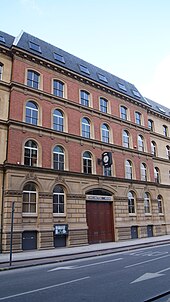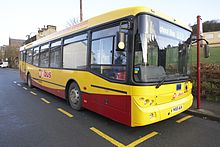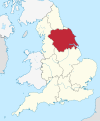 | |
| Company type | Passenger Transport Executive |
|---|---|
| Industry | Public transport |
| Founded | 1 April 1974 (Local Government Act 1972) |
| Defunct | 1 April 2014 (Brand name still used by West Yorkshire Combined Authority) |
| Headquarters | Wellington House 40–50 Wellington Street Leeds England |
| Area served | West Yorkshire |
| Parent | West Yorkshire Combined Authority |
| Website | wymetro |
Metro is the passenger information brand used by the West Yorkshire Combined Authority in England. It was formed on 1 April 1974 as the West Yorkshire Passenger Transport Executive (WYPTE), at the same time as the metropolitan county of West Yorkshire. The Metro brand has been used from the outset and, since the formal abolition of the WYPTE on 1 April 2014, it has remained the brand name of public transport in the region, overseen by the West Yorkshire Combined Authority, which is also responsible for the delivery of transport policies.
Governance


Metro is a public transport brand of the West Yorkshire Combined Authority which is, through its transport committee, the transport authority for West Yorkshire. It replaced the West Yorkshire Integrated Transport Authority on 1 April 2014. The West Yorkshire County Council was the transport authority from 1 April 1974 until 1 April 1986. It was replaced by the West Yorkshire Passenger Transport Authority that was made up of elected councillors from the districts of West Yorkshire. The West Yorkshire Passenger Transport Authority was renamed the West Yorkshire Integrated Transport Authority following the Local Transport Act 2008. The Metro brand was adopted in 1988.
MetroBus History
Buses are operated by private companies, with early morning, late evening, Sunday and rural services often supported by Metro. There is a special rural bus section, which promotes a combination of minor local links and major long-distance routes.
On 1 April 1974, the West Yorkshire Passenger Transport Executive was created by merging the municipal bus fleets of Bradford City Transport, Leeds City Transport, Huddersfield Corporation Passenger Transport and Halifax Joint Omnibus Committee, which earlier in the 1970s swallowed up Todmorden Joint Omnibus Committee. The operation was divided into four districts and a new livery of cream and verona green replaced the Bradford light blue & cream, Huddersfield red & cream, Leeds two-tone green and Halifax & Calderdale orange, green & cream. Created following the Local Government Act 1972, the Executive had to operate within the policy guidelines of the County Council Public Transport Committee, coordinating the operation of all public transport in the county. The Executive inherited approximately 1,500 buses along with 6,000 staff and the associated garages and street furniture.
The Executive relinquished ownership of local buses following the Transport Act 1985, creating arms-length operating companies. It continued to coordinate public transport as the West Yorkshire Passenger Transport Authority when the metropolitan county was abolished in 1986. New buses were purchased in large numbers at the outset. In 1976 Baddeley Brothers of Holmfirth was purchased providing the PTE with additional coaching and stage-carriage duties. In 1980 the Baddeley Brothers business was also disposed of, although the Metrocoach operation was retained.
Fleet livery

In 1976 modifications were made to the livery. Originally there were three stripes at the sides of the destination box, which wrapped round to the sides and swept down. This took time to apply, and a trial was made with one thin line. In 1977 the lines were removed and the green area at the skirting of was raised up, so there was slightly more green. The other change was the fleet name to MetroBus in 1976, removing the district names.
On 25 April 1977, the PTE acquired the old-established Kinsley based United Services from WR & P Bingley. As well as providing the PTE with more coaching operations, this took it into an area of West Yorkshire where it had previously had no presence. United Services was maintained as a separate subsidiary and retained its distinctive blue livery, whilst a new livery of red & ivory was adopted for the PTE's coaches, which operated under the "Metrocoach" banner, with brown added for "Metrocoach Executive". Later Bingley's depot received double-deckers transferred from the Leeds District. In early 1981 a reorganisation of operating districts was implemented with the East District becoming responsible for the Leeds depots and United Services, whilst the West District took control of Bradford, Halifax, Todmorden and Huddersfield. Three new Leyland National 2s were acquired for United Services, in blue livery.
New integrated bus system
In July 1981, MetroBus and the National Bus Company (NBC) formed a new integrated transport system known as the "Metro-National Transport Company Limited". All PTE and NBC buses began to appear with a new emblem, which consisted of the MetroBus WY's in one box and the NBC "double N" or "N-blem" appearing in another to the right of the PTE emblem, and slightly lower. The boxes were linked to show the integration. They also appeared with MetroBus fleetnames with "The easy way from here to there in West Yorkshire". The new "Metrobus" fleetname being applied not only to PTE owned vehicles on which WYPTE lettering was carried beneath the fleet name, but also buses of NBC subsidiaries West Yorkshire Road Car Company, West Riding Automobile Company, Yorkshire Woollen Transport Company and Yorkshire Traction, carrying "West Yorkshire", "West Riding", "Yorkshire" and "Yorkshire Traction" names below the Metrobus name. Some years later some of those buses (excluding Yorkshire Traction) were repainted into the PTEs verona cream and buttermilk livery so as to present a corporate image. From this date the "WY" logo on the front of buses was replaced by the "Metro-National" emblem in mid-1983, to celebrate 100 years of public transport in Huddersfield, MetroBus paint two vehicles in old liveries: Leyland Atlanteans carried Huddersfield Corporation red livery and Huddersfield Corporation Tramways livery. They became "Building on a Great Tradition" vehicles and were in those liveries until the late 1990s.
Deregulation

Deregulation occurred on 26 October 1986. The WYPTE bus division was renamed Yorkshire Rider and with it a new livery of dark olive green and cream and a stylised "YR" emblem. Five double-decker buses were operated in each of the municipal council's colours (already included were the two Huddersfield buses), with words on the sides between the decks saying "Building on a Great Tradition". The bus services and fare/bus pass/timetables division was renamed Metro.
Fleetlist

- Leyland Titan PD3 1974–1976
- Daimler Fleetline 1974–1976
- AEC Regent III 1974–1976
- Leyland Atlantean 1974–1986
- Daimler CVG.VI 1974–1976
- Daimler SRG.VI 1974–1976
- AEC Swift 1974–1976
- Leyland Panther 1974–1976
- Leyland Leopard 1974–1976
- Leyland Royal Tiger 1974–1976
- AEC Reliance 1974–1976
- Seddon Pennine RU 1974–1976
- Guy Arab Mk IV 1974–1976
- Scania Metropolitan 1975–1985
- Leyland Olympian 1980–1986
- MCW Metrobus 1980–1986
- Duple Dominant 1983–1986
'My bus' school bus services

| This section needs to be updated. Please help update this article to reflect recent events or newly available information. (September 2023) |
My bus is a school bus service provided by West Yorkshire Metro with certain features which set it apart from normal school transport services in the United Kingdom:
- a dedicated fleet of school buses (rather than ordinary transit buses or coaches borrowed from other duties); additional use of these vehicles is limited to school and young-person focussed activities and all have low floors and seat belts
- drivers with enhanced DBS checks, who permanently assigned to each route, assisted on some routes by volunteer escorts
- a bus seat is permanently assigned to each student
- in-school education campaign to support the service
The service, using buses painted yellow with coordinated My bus branding gained significant mode shift: 64% of primary school users were previously driven by car. Under this scheme, these buses were not allowed to be used for non-school purposes.
West Yorkshire Metro claims benefits from 'My bus' ranging from reductions in car use, traffic congestion, air pollution, traffic accidents, social exclusion, truancy and late student arrivals and improvements to education, safety for pedestrians and cyclists, integration of people with special needs and children's experiences of public transport. As of August 2009 the current My bus contractors were City Travel, First Student UK (First Calderdale & Huddersfield, First Leeds), HCT Group, Keighley Bus Company, Rollinson Safeway, Tiger Blue and TLC Travel.
Current operators
As of 2012 the following companies are owned by WYPTE, subject to Metro conditions and ticketing:
- Metroconnect Accessbus in WYPTE Area.
Rail service
| West Yorkshire MetroTrain | |||
|---|---|---|---|
| Overview | |||
| Locale | West Yorkshire | ||
| Transit type | Commuter rail | ||
| Number of lines | 12 | ||
| Annual ridership | 34.9 million (2014-15) | ||
| Operation | |||
| Operator(s) | Northern Trains | ||
| |||

Local and inter-urban rail services within West Yorkshire and the surrounding areas, part funded by Metro, were advertised under the MetroTrain brand. In the 1990s, some Class 141, 144, 155, 158, 308, 321 and 333s were painted in Metro livery. The Class 333 was painted in Metro livery when built. All apart from the 333s were later repainted in Northern Rail livery. Some of the 144s and 155s were originally purchased by the WYPTE but were later sold to Porterbrook. Metro retained ownership of the 158 and 321s which were leased to the Northern franchise holder.
Routes
There are 12 commuter railway lines serving West Yorkshire: Airedale, Calder Valley Line, Dearne Valley, Hallam, Harrogate, Huddersfield, Leeds-Bradford, Penistone, Pontefract, Wakefield, Wharfedale and York & Selby.
The majority of these lines run into Leeds and most continue into neighbouring areas, serving towns and cities such as Barnsley, Blackpool, Doncaster, Harrogate, Liverpool, Manchester, Nottingham, Preston, Sheffield and York. Some lines overlap each other, which means that stations such as Castleford, Huddersfield and Wakefield Westgate are served by more than one line.
Most lines have frequent services, but the Dearne Valley line has a limited service of two trains a day in each direction.
In the following list of routes in West Yorkshire, places shown in bold are where services terminate, places shown in italics are stations located outside of West Yorkshire.
| Airedale Line | Calder Valley Main Line | Dearne Valley Line | Hallam Line | Harrogate Line | Huddersfield Line |
|---|---|---|---|---|---|
|
then: or: then continues along Settle-Carlisle Line to: or continues along Leeds-Morecambe Line to: |
Operators: Northern, Grand Central then: or: then: or: |
Operator: Northern |
Operator: Northern |
Operators: Northern, TransPennine Express or: then: then: or: then: or: then: or: |
| Leeds/Bradford Line | Penistone Line | Pontefract Line | Wakefield Line | Wharfedale Line | York & Selby Line |
|---|---|---|---|---|---|
|
then: or: |
Operators: Northern |
Operators: Northern, Grand Central then: or: |
Operators: Northern, LNER, CrossCountry then: or: |
Operator: Northern or: then: |
Operators: Northern, TransPennine Express, CrossCountry then: or: continues to Middlesbrough, Newcastle and Scarborough |
Notes:
| 1 | Although stations are in North Yorkshire, MetroCards are valid at these stations |
|---|---|
| 2 | Limited Service only |
| 3 | Service continues along Caldervale Line to Manchester Victoria via Hebden Bridge |
Re-opened stations


WYPTE has had a programme of reopening railway stations throughout its existence and has opened or reopened over 20 stations:
- 1982 – Deighton, Fitzwilliam, Crossflatts and Slaithwaite
- 1983 – Bramley
- 1984 – Saltaire
- 1987 – East Garforth, Sandal & Agbrigg and Frizinghall
- 1988 – Burley Park, Outwood, Cottingley and Cononley (just outside West Yorkshire but since 2009 part of the WYPTE area, which now extends to Skipton)
- 1989 – Berry Brow
- 1990 – Walsden and Steeton & Silsden
- 1992 – Streethouse, Featherstone, Pontefract Tanshelf, on 12 May, when the line between Pontefract Monkhill and Wakefield Kirkgate reopened to passengers
- 2000 – Brighouse, when the Halifax to Huddersfield link re-opened to passengers
- 2005 – Glasshoughton
- 2015 – Apperley Bridge
- 2016 – Kirkstall Forge
- 2017 – Low Moor
White Rose Centre had been expected to open in 2023. The station was to replace nearly Cottingley station, due to its close proximity. Consequently, Cottingley would close, and this was ratified by The Office of Road and Rail in February 2023. However, construction was halted in March 2024 due to increased costs, and as of August 2024 it was unclear when construction would resume.
Elland is due to re-open in the middle of the decade. Planning permission was given in March 2023, and construction is expected to begin in 2024 for a potential opening date of December 2025.
Also planned is a station at Thorpe Park, and a station serving Leeds Bradford Airport is also proposed.
Operators
Most local services are run by Northern Trains, and longer-distance routes are served by TransPennine Express, London North Eastern Railway, CrossCountry and Grand Central.
Leeds Supertram
In 2001, Metro came up with Leeds Supertram, with the idea of bringing back a tram network for Leeds. After the original scheme exceeded its budget, the Government asked Metro to look at ways of reducing costs. In spring 2005 Metro went back to the Government with a re-costed plan but the Secretary of State for Transport Alistair Darling rejected the proposal after the 2005 general election. Darling responded by pointing to plans by a private bus operator for a bus system where the vehicles were designed to look like trams.
This is not the first time such a scheme has been unsuccessfully pursued. In the mid-1980s the PTE was interested in bringing back trolleybuses in Bradford with Yorkshire Rider awarded a contract to operate, but nothing came of it.
References
- Colin Speakeman (1985). Public Transport in West Yorkshire, Ten Years of Achievement. Metro–West Yorkshire Passenger Transport Executive. ISBN 0-9510201-0-2.
- "M for Metro" The Railway Magazine issue 1043 March 1988 page 147
- Arnold-Baker, C., Local Government Act 1972, (1973)
- Her Majesty's Stationery Office, Aspects of Britain: Local Government, (1996)
- ^ "Metro – Mybus-schoolbuses – 'My bus' school transport: How it works". Metro. Retrieved 7 January 2011.
- ^ "Metro – Executive Summary – My bus report" (PDF). Metro. Retrieved 9 September 2009.
- "WestYorkshireBusesWebsite . . . . a to z". West Yorkshire Buses. Archived from the original on 8 October 2011. Retrieved 1 September 2023.
- "Metro – Buses – Bus Operators". Metro. Retrieved 17 March 2011.
- "West Yorkshire Transport Strategy Evidence Base" (PDF). www.westyorks-ca.gov.uk. July 2016. Retrieved 12 March 2019.
- "West Yorkshire DMUs sold to Porterbrook". Railway Gazette International. 23 May 2011.
- "Porterbrook acquires WYPTE vehicles". Today's Railways UK. No. 115. July 2011. p. 66.
- "Metro – Timetables & routes – West Yorkshire's rail network timetable". Metro. Retrieved 10 September 2010.
- "Metro – Timetables & routes – Train routes and timetables". Metro. Retrieved 10 September 2010.
- "White Rose Rail Station". West Yorkshire Combined Authority. 2022.
- "Closure Ratification Notice – Cottingley station" (PDF). Network Rail. 27 February 2023. Retrieved 13 March 2023.
- Jones, Leigh (19 March 2024). "White Rose railway station: Building work on a new railway station halted after 'unforeseen increase in costs'". The Yorkshire Post. Retrieved 8 May 2024.
- Grant, Alex (25 April 2024). "White Rose Station: Work on new Leeds train station remains on hold over cost concerns". Yorkshire Evening Post. Retrieved 8 May 2024.
- Stokes, Spencer (12 June 2024). "Uncertainty over future of new railway station". BBC News. Retrieved 17 August 2024.
- "Elland on track for a new station". News Centre - Official news site of Calderdale Council. Retrieved 1 August 2017.
- "Elland Railway Station gets planning go-ahead - here's when it could be built by". Halifax Courier. Retrieved 15 March 2023.
- The Railway Magazine. No. January 2018. January 2018.
{{cite magazine}}: Missing or empty|title=(help) - Rider wins Bradford Commercial Motor 8 June 1989
External links
- West Yorkshire Metro website
- History of Yorkshire Rider West Yorkshire Buses
| Passenger transport executives in the United Kingdom | |||||
|---|---|---|---|---|---|
| Current |
| ||||
| Former |
| ||||
| Bus operators in Yorkshire and the Humber | ||
|---|---|---|
| East Riding of Yorkshire |  | |
| Northern Lincolnshire | ||
| North Yorkshire | ||
| South Yorkshire (PTE) | ||
| West Yorkshire (PTE) | ||
| National | ||
